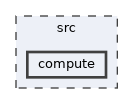Loading...
Searching...
No Matches
compute Directory Reference
Compute back ends.
More...
Directory dependency graph for compute:

Files | |
| compute.cpp | |
| compute.h | |
| lua_compute.cpp | |
| opencl.cpp | |
| opencl.h | |
| pseudo.cpp | |
Detailed Description
Compute back ends.
Compute back ends for task execution in heterogeneous compute devices.
- OpenCLBackend: main/default OpenCL 1/2 back end.
- Pseudocomp: fake back end for testing.
- An absent back end is also supported, in which case native CPU code is used.
The following area of the screenshots page shows some of the compute capabilities:
https://bbguimaraes.com/nngn/screenshots/compute.html
Lua
The compute back end is exposed to Lua via the nngn.compute variable. Compiling a program and executing a kernel is done similarly to the C++ API:
nngn.compute:execute(prog, "fn", Compute.BLOCKING, {256, 256}, {16, 16}, {
Compute.FLOAT, 3.1415,
Compute.BYTEV, {0, 1, 2, 3},
})
Definition audio.cpp:7
Compute.BLOCKING makes the execution synchronous. Kernels can also be executed concurrently (requires a device with an out-of-order queue) and synchronized using events:
events = {}
-- Last two arguments are wait list and output events.
nngn.compute:execute(prog, "k0", 0, {1}, {1}, {}, nil, events)
-- Reuse output.
-- Wait for all previous events, reuse output.
nngn.compute:execute(prog, "k2", 0, {1}, {1}, {}, events, events)
-- Wait for all previous events and release them.
nngn.compute:wait(events)
auto compute(nngn::Compute *c)
Definition lua_collision.cpp:24
auto wait(const Compute &c, std::vector< const void * > events)
Definition lua_compute.cpp:466
bool release_events(const Compute &c, std::vector< const void * > events)
Definition lua_compute.cpp:477
bool execute(Compute &c, lua_Integer program, const char *func, Compute::ExecFlag flags, nngn::lua::table_view global_size, nngn::lua::table_view local_size, nngn::lua::table_view data, std::optional< nngn::lua::value_view > wait_opt, std::optional< nngn::lua::table_view > events_opt)
Definition lua_compute.cpp:591
constexpr struct nngn::lua::nil_type nil
Separate tables can be used to construct more complex task graphs.
Buffers
To create and populate a device buffer:
Common operations on buffers are creation:
rw = Compute.READ_WRITE
-- From existing data.
rw, Compute.FLOATV, size,
Compute.create_vector(1024)))
write:
and read: